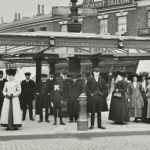Black hair paired with a floppy fringe, framed by smoky eyes, along with the sounds of bands like Green Day, encapsulates the memories many hold of the emo subculture from the early 2000s.
An exhibition titled I’m Not Okay: An Emo Retrospective has become a major attraction at the Barbican Music Library, drawing over 35,000 visitors eager to relive those days.
The walls of the venue are adorned with striking visuals depicting crowded concerts, unguarded backstage interactions, and heartfelt images of the emo youth.
This exhibition has not only revived fond memories for many but has also offered the emo community an opportunity to reconnect and share their experiences from that era.
AJ Turner, a 32-year-old musician, recalls his teenage years, saying, “For me, the emo subculture was far more than just a lifestyle in the early 2000s. It served as a vital support system during a time marked by severe depression, isolation, and bullying. My life revolved around attending emo concerts where I finally felt understood and part of a caring community,” he shared with the BBC World Service.
Visitors recognized AJ from the photographs displayed, noting that the spirit of community remains alive today.
Identifying as emo, AJ emphasizes how the music he creates is deeply rooted in that transformative time. “I used to wear an ‘MCR (My Chemical Romance) saved my life’ T-shirt to shows, and I still feel that way today,” they noted.
Emo culture, characterized by its unique music, fashion, and emotional expression, reached its zenith in the 2000s with bands like My Chemical Romance and anthems such as “Welcome To the Black Parade” achieving widespread popularity.
The exhibition explores themes of identity, angst, and emotional release, illustrating a generation’s quest for connection and self-definition.
Many lyrics from bands classified as emo touched on thoughts of self-harm, which prompted some artists to distance themselves from the genre, contributing to its perceived decline in mainstream visibility.
“While the media often criticized our subculture, it provided a lifeline for many of us navigating tough times,” reflected AJ.
Jamie Brett, the creative director and curator at the Museum of Youth Culture, describes it, stating, “We’re examining the youthquake that emerged in the mid-2000s. The public’s mindset then portrayed a grim outlook for young people, and their fashion choices were a reflection of that reality. Emo became our beacon of hope for the future.”
According to Jamie, emo emerged in Washington, D.C., during the 1980s before evolving into a subculture known as scene in the late 2000s, characterized by its vibrant fashion, extravagant hairstyles, and eclectic layering of clothes.
Social media platforms like MySpace, Buzznet, and hi5 enabled young individuals to showcase their unique styles to a global audience. “For the first time, young people harnessed the internet for self-expression—it marked the rise of the first digital subculture,” Jamie explained.
In front of a memory wall packed with notes and screenshots from old MySpace accounts, three women animatedly converse about the exhibition. “It’s so cool, fun, and adorable—it just brightens your day,” they exclaimed in unison.
Maddie, Seren, and Molly, students visiting the exhibition to celebrate Seren’s birthday, shared their thoughts. “It’s wonderful to see others’ personal emo journeys,” Molly stated. “I’m emo at heart,” Seren added. “I grew up immersed in it thanks to my older siblings, making it nostalgic for me.” Her first concert was by the beloved emo band Fall Out Boy, and after attending an MCR show last year, she represents the new wave of emos carrying on the tradition.
All the displayed images have been submitted by the public, and the museum invites anyone with photos or memories from the noughties era to reach out.
The complimentary exhibition at the Barbican Centre is a partnership between the Museum of Youth Culture and the Barbican Music Library, running until February 7th.


